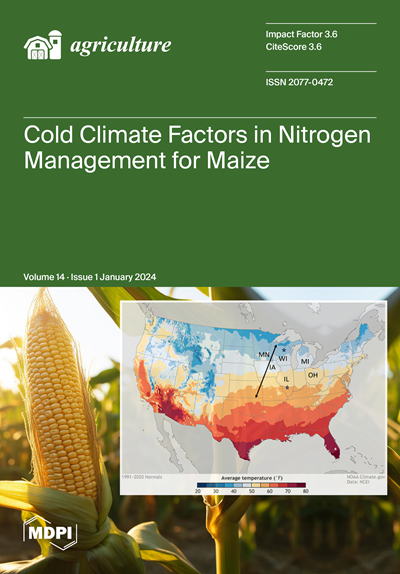Application of OpenAir and AgDRIFT Models to Estimate Organophosphate Pesticide Spray Drift: A Case Study in Macon County, Alabama
IF 3.6
2区 农林科学
Q1 AGRONOMY
引用次数: 0
Abstract
Pesticides have been widely used in agriculture, resulting in significant pollution that affects both the environment and human health. This pollution is particularly prevalent in nearby agricultural areas, where sensitive resources are contaminated through spray drift exposure and surface runoff. Spray drift is a critical concern when it comes to environmental hazards. It poses health risks not only to farmers and pesticide applicators, but also to individuals living in nearby farm areas. To address this issue, developing reliable models and techniques for estimating spray drift and reducing its impact has become a crucial and efficient research topic. The current research has three primary objectives: firstly, to estimate the average pesticide application rates, trend analysis, and concentration distribution; secondly, to estimate the temporal variations of pesticide concentrations and identify the areas most likely to be affected by pesticide spray drift close to agricultural fields; and lastly, to develop a model for field spray drift and deposition integration between the OpenAir package for the R programming environment and the AgDRIFT atmospheric model. The drift model, along with precise supervised classifications, allowed for a more accurate estimation of potential drift in agricultural areas at a spatial resolution of 15 m. Additionally, multiple scenarios were conducted to evaluate the potential risks of pesticide drift outside of the target areas. This novel method effectively estimated organophosphate pesticide spray drift over two case studies in Macon County using a combination of OpenAir and AgDRIFT models and remotely sensed data. This method allowed for field simulations within completely defined exposure areas with little prior knowledge of pesticide quantities. This study concluded that 6% of total cropland is in danger of pesticide spray drift, with around 8% of crop areas exposed to potential strong drift on land use. Furthermore, 11% of cropped land is vulnerable to moderate drift, whereas around 75% of land use land cover is not vulnerable to pesticide drift. Through this research, an accurate and efficient approach has been developed to estimate spray drift and reduce its impact in agricultural areas, contributing to a safer and healthier environment for all.应用OpenAir和AgDRIFT模型估算有机磷农药喷雾漂移:以阿拉巴马州梅肯县为例
农药在农业中被广泛使用,造成了严重的污染,影响了环境和人类健康。这种污染在附近的农业区尤其普遍,那里的敏感资源通过喷雾漂移暴露和地表径流受到污染。当涉及到环境危害时,喷雾漂移是一个关键问题。它不仅对农民和农药施用者构成健康风险,而且对居住在附近农场地区的个人也构成健康风险。为了解决这一问题,开发可靠的模型和技术来估计喷雾漂移并减少其影响已成为一个重要而有效的研究课题。目前的研究主要有三个方面:一是估算农药平均施用量、趋势分析和浓度分布;其次,估算农药浓度的时间变化,确定农药喷雾漂移最可能影响农田的区域;最后,在R编程环境的OpenAir软件包和AgDRIFT大气模型之间开发一个现场喷雾漂移和沉积集成模型。漂移模型加上精确的监督分类,可以在15米的空间分辨率下对农业地区的潜在漂移进行更准确的估计。此外,还进行了多种情景评估,以评估农药在目标区外漂移的潜在风险。这种新方法结合OpenAir和AgDRIFT模型以及遥感数据,有效地估算了梅肯县两个案例研究中的有机磷农药喷雾漂移。这种方法允许在完全确定的暴露区域内进行现场模拟,而事先对农药数量知之甚少。这项研究得出的结论是,6%的耕地面临农药喷雾漂移的危险,约8%的作物地区面临土地利用潜在的强烈漂移。此外,11%的耕地易受中度漂移的影响,而约75%的土地利用土地覆盖不容易受到农药漂移的影响。通过这项研究,开发了一种准确和有效的方法来估计喷雾漂移并减少其对农业地区的影响,从而为所有人创造一个更安全和更健康的环境。
本文章由计算机程序翻译,如有差异,请以英文原文为准。
求助全文
约1分钟内获得全文
求助全文
来源期刊

Agriculture-Basel
Agricultural and Biological Sciences-Food Science
CiteScore
4.90
自引率
13.90%
发文量
1793
审稿时长
11 weeks
期刊介绍:
Agriculture (ISSN 2077-0472) is an international and cross-disciplinary scholarly and scientific open access journal on the science of cultivating the soil, growing, harvesting crops, and raising livestock. We will aim to look at production, processing, marketing and use of foods, fibers, plants and animals. The journal Agriculturewill publish reviews, regular research papers, communications and short notes, and there is no restriction on the length of the papers. Our aim is to encourage scientists to publish their experimental and theoretical research in as much detail as possible. Full experimental and/or methodical details must be provided for research articles.
 求助内容:
求助内容: 应助结果提醒方式:
应助结果提醒方式:


